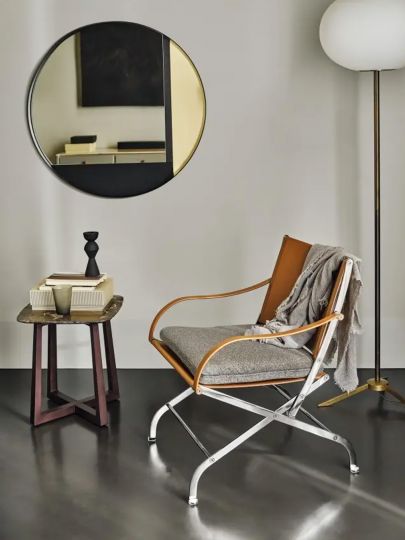Classic Revisited
In Milan, a flat with a terrace in a building dating from the early 1900s underwent a renovation that reclaimed its history through stylish design choices, bringing it into harmony with the present.
The first step was to purchase the property, a roughly 140 square-metre apartment on the first floor of a historic building.While the owner initially desired a higher floor, the 50 square-metre terrace proved to be the deciding factor. The apartment's square floor plan, symmetry, and dual exposure were precisely what he sought. A 1972 renovation had obliterated all traces of the 18th century. However, the removal of a false ceiling revealed a pleasant surprise: the original paintings of that period. The entire apartment was gutted, including, of course, the false ceilings. The house was liberated,its history brought back to light. This led to a redefinition of the rooms, giving the apartment a decidedly contemporary feel.
Dual access points to each room were a specific request of the homeowner. The resulting dwelling is an exercise in fluidity, with unusual connections: only the bathrooms have a single entrance and exit. One can move freely from the dining room, with its frescoed ceilings and striking chandeliers, to the bedroom, featuring a Lifesteel bed and a small reading nook, to the kitchen, where Moka chairs are reflected in the stainless-steel floor, to the living room.
The living room ceiling is particularly impressive. The beams were lacquered black, and to introduce light into the room,a backlit sheet of micro-perforated brass was installed, visually doubling the vertical space. Interior design choices placed Perry Up and Guscio sofas front and centre; both designed by Antonio Citterio. The overall colour palette is warm and earthy.
The walls had originally been decorated, as discovered during further examination. However, the homeowner wanted to move into the apartment quickly, and restoring all the art would have taken much longer than planned. The solution was to install plasterboard panels with a simple locking system that would allow access, at a later date, for the restoration of the paintings. Reflective mirrored surfaces abound, serving as additional "doors" that expand the space and create visual continuity between the various rooms.
The spacious terrace, accessible from the living room, offers a view that extends the reach of the room. It also connects the street side of the building with a more internal one. The lushly planted terrace is for the exclusive use of the apartment; in pleasant weather, it serves as an alfresco dining area where meals are enjoyed while comfortably seated on Moka Outdoor chairs around the Fly Outdoor table. A conversation corner with Alison armchairs is also located nearby.The terrace provides access to another room, in a second part of the building, that the owner uses as a home gym.






















